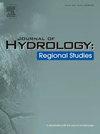伊朗乌尔米亚高盐湖的分层与混合动力学
IF 5
2区 地球科学
Q1 WATER RESOURCES
引用次数: 0
摘要
研究区域:伊朗西北部乌尔米亚湖研究重点:研究临界生态胁迫下跨界高盐湖乌尔米亚湖的分层和垂直混合动力学。利用多年高分辨率的原位温度和盐度测量(2016-2019),我们表征了季节混合模式,并量化了盐度和温度对垂直水柱稳定性的相对贡献。采用湖泊特定密度公式和热能估算来评估不同季节阶段的浮力结构和倾覆动力学。来自该地区的新水文地质见解:乌尔米亚湖表现出双相混合状态,在温暖季节具有周期性的全深度混合,在寒冷季节由于盐度增强的密度分层而具有逆单相混合。盐度是主要的稳定因素,而温度起辅助作用,主要是作为长期示踪剂。该湖被归类为高盐生湖,混合是由盐度控制的,而不是经典的热分层。发现了一种季节性盐度泵机制:冬季卤水排斥使分层加深,而夏季岩盐再溶解则对分层产生侵蚀作用。湖床沉积物的热惯性有助于持续的冷相分层。研究结果表明,垂直解耦增加,倾覆减少,生态压力风险增加。这些见解有助于提高对高盐湖泊行为的理解,并可以指导全球类似终端湖泊的监测和恢复策略。本文章由计算机程序翻译,如有差异,请以英文原文为准。

Stratification and mixing dynamics of hypersaline Lake Urmia (Iran)
Study region:
Lake Urmia, northwestern Iran
Study focus:
This study investigates the stratification and vertical mixing dynamics of Lake Urmia, a transboundary hypersaline lake under critical ecological stress. Using multi-year, high-resolution in-situ temperature and salinity measurements (2016–2019), we characterize seasonal mixing patterns and quantify the relative contributions of salinity and temperature to vertical water column stability. A lake-specific density formulation and thermal energy estimates are applied to assess buoyancy structure and overturn dynamics across contrasting seasonal phases.
New hydrogeological insights from the region:
Lake Urmia exhibits a dual-phase mixing regime, polymictic during the warm season with recurrent full-depth mixing, and inverse meromictic during the cold season due to salinity-enhanced density stratification. Salinity is shown to be the dominant stabilizing factor, while temperature plays a supporting role, primarily as a long-term tracer. The lake is classified as Hyperhalimictic, where mixing is governed by salinity rather than classical thermal stratification. A seasonal salinity pump mechanism is identified—winter brine rejection deepens stratification, while summer halite re-dissolution erodes it. Thermal inertia in lakebed sediments contributes to persistent cold-phase stratification. Findings indicate a trend toward increasing vertical decoupling, reduced overturning, and elevated risk of ecological stress. These insights support improved understanding of hypersaline lake behavior and can guide monitoring and resilience strategies in similar terminal lakes worldwide.
求助全文
通过发布文献求助,成功后即可免费获取论文全文。
去求助
来源期刊

Journal of Hydrology-Regional Studies
Earth and Planetary Sciences-Earth and Planetary Sciences (miscellaneous)
CiteScore
6.70
自引率
8.50%
发文量
284
审稿时长
60 days
期刊介绍:
Journal of Hydrology: Regional Studies publishes original research papers enhancing the science of hydrology and aiming at region-specific problems, past and future conditions, analysis, review and solutions. The journal particularly welcomes research papers that deliver new insights into region-specific hydrological processes and responses to changing conditions, as well as contributions that incorporate interdisciplinarity and translational science.
 求助内容:
求助内容: 应助结果提醒方式:
应助结果提醒方式:


